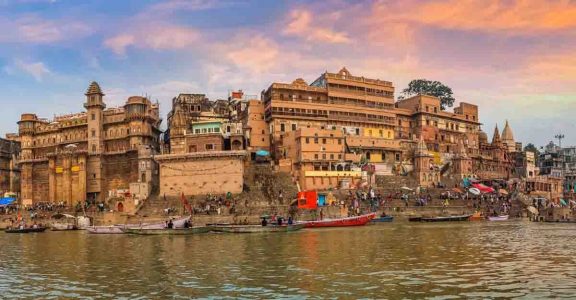Varanasi, also known as Kashi or Benares, is one of the oldest and holiest cities in India. Located on the banks of the sacred River Ganges, Varanasi is a spiritual epicenter for Hindus, attracting pilgrims from all over the world. The city is renowned for its ancient ghats, where devotees perform rituals and take holy dips, and its numerous temples, each with its unique significance. A journey through Varanasi is not just a physical exploration but a deep spiritual experience that connects one with the divine. Here’s a guide to the must-visit ghats and temples in Varanasi.
- Dashashwamedh Ghat: The Heart of Varanasi
Dashashwamedh Ghat is the most famous and vibrant ghat in Varanasi. According to legend, Lord Brahma performed the Dashashwamedha Yajna (ten-horse sacrifice) at this ghat, giving it its name. The ghat is the focal point of Varanasi’s spiritual activities, especially during the evening Ganga Aarti, a mesmerizing ritual of lights, chants, and incense offered to the River Ganges. The aarti, performed by priests in traditional attire, is a sight to behold and is considered a highlight of any visit to Varanasi. The ghat is also a popular spot for pilgrims to take a holy dip in the Ganges, believed to cleanse them of their sins.
- Manikarnika Ghat: The Sacred Cremation Ground
Manikarnika Ghat is one of the most sacred and ancient ghats in Varanasi, known as the “gateway to heaven.” It is the primary cremation ghat in the city, where Hindus believe that being cremated here grants liberation (moksha) from the cycle of birth and death. The ghat is named after the Manikarnika Kund, a sacred well that is said to have been created by Lord Vishnu. The sight of funeral pyres burning continuously at the ghat can be overwhelming, but it is a profound reminder of the transient nature of life and the spiritual significance of Varanasi.
- Assi Ghat: The Tranquil Ghat
Located at the confluence of the Assi River and the Ganges, Assi Ghat is one of the most tranquil and serene ghats in Varanasi. It is a popular spot for morning yoga sessions and for witnessing the sunrise over the Ganges. The ghat is also known for its laid-back atmosphere, attracting both pilgrims and tourists looking for a peaceful place to meditate or relax. The nearby Shivala Ghat and the Tulsi Ghat, associated with the poet-saint Tulsidas, are also worth visiting. Assi Ghat is an ideal spot for those seeking a quiet spiritual experience in Varanasi.
- Kashi Vishwanath Temple: The Holiest Shrine
The Kashi Vishwanath Temple, dedicated to Lord Shiva, is the most revered temple in Varanasi and one of the twelve Jyotirlingas (shrines where Shiva is worshipped as a lingam of light). The temple is located near the Dashashwamedh Ghat and is a major pilgrimage site for Hindus. The temple complex has been rebuilt several times, with the current structure dating back to the 18th century, built by the Maratha ruler, Ahilyabai Holkar. The Kashi Vishwanath Temple is believed to be the place where Lord Shiva himself resides, making it one of the most spiritually significant sites in Varanasi. Devotees from all over the world visit the temple to offer prayers and seek blessings. The temple’s golden spire, donated by Maharaja Ranjit Singh, adds to its grandeur, and the sound of bells and chants fills the air, creating a deeply spiritual ambiance.
- Sankat Mochan Hanuman Temple: The Protector
Dedicated to Lord Hanuman, the Sankat Mochan Hanuman Temple is one of the most revered temples in Varanasi. The temple is believed to be founded by the poet-saint Tulsidas, the author of the Ramcharitmanas. The name “Sankat Mochan” means “reliever of troubles,” and it is said that worshiping Hanuman at this temple helps devotees overcome their difficulties and challenges. The temple is particularly popular on Tuesdays and Saturdays, which are considered auspicious days to worship Hanuman. The temple premises are filled with the sweet scent of marigolds and the sound of Hanuman Chalisa recitations, offering a peaceful and devotional atmosphere.
- Durga Temple: The Goddess of Power
The Durga Temple, also known as the Monkey Temple due to the presence of numerous monkeys in the area, is dedicated to Goddess Durga, the embodiment of feminine power and strength. The temple, built in the 18th century, is a striking example of North Indian architecture with its red-colored walls and multi-tiered spires. The temple is a significant site during the Navratri festival when devotees flock to offer prayers and participate in rituals. The adjacent Durga Kund, a rectangular tank, adds to the temple’s serene and sacred environment.
- Tulsi Manas Temple: A Literary Shrine
The Tulsi Manas Temple, dedicated to Lord Rama, is one of the most important temples in Varanasi from a cultural and literary perspective. The temple is built on the site where Tulsidas is believed to have written the Ramcharitmanas, an epic poem in Awadhi language based on the Ramayana. The temple’s walls are adorned with verses and scenes from the Ramcharitmanas, making it a place of great reverence for followers of Lord Rama. The temple’s peaceful surroundings and literary significance attract both devotees and scholars alike.
Conclusion
A spiritual journey through Varanasi is a transformative experience that touches the soul. From the sacred ghats where rituals and ceremonies unfold daily to the ancient temples that echo with prayers and hymns, Varanasi offers a deep connection to India’s spiritual heritage. Each ghat and temple in Varanasi has its own story, contributing to the city’s unique and mystical aura. Whether you are seeking solace, spiritual growth, or simply a deeper understanding of India’s rich cultural tapestry, Varanasi’s ghats and temples provide a profound and unforgettable experience.
Embrace the spirituality of Varanasi, and let the city’s ancient wisdom and sacred traditions guide you on your journey of self-discovery.

